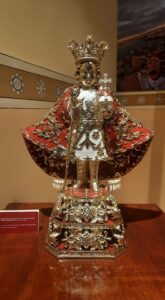By: Consul General Maria Theresa SM. Lazaro
SINCE I am not really an expert on the history of the Sto. Nino, I can only mention what I know from what I have read. The image of Sto. Nino must have originated in Spain in the early 16th century and usually underscored the idea of kingship. From Spain, the devotion to the image of the Infant Jesus must have spread across Europe and became in Belgium, as the Sto. Nino de Cebu, believed to have been made by Flemish artisans.
The image must have been brought to the Philippines by the Magellan expedition when they sailed from Seville, Spain in 1519 in search of a maritime route to East Asia through the Americas and across the Pacific. The same image was later given to Rajah Humabon and his wife in 1521 after the latter were baptized into Christianity.
The ongoing exhibit of the Sto. Nino is actually a follow-through event to the Presentation of the Sto. Nino de Cebu to the Basilica de la Sagrada Familia during an international mass on December 5, 2021. The mass was part of the Consulate’s commemorative activities/projects for the 500 years of the First Circumnavigation of the Globe and the 500 years of the advent of Christianity in the Philippines. The exhibit was inaugurated by His Eminence Cardinal Luis Antonio Tagle, together with Philippine Ambassador to Spain Philippe J. Lhuiller, myself, and DFA Assistant Secretary Eduardo Menez. The exhibit will run until May 31, 2022 after which, the Consulate intends to donate some of the Santo Nino images to various churches where most Filipinos attend mass.
The Consulate also plans to loan the image of Sto. Nino de Cebu that was presented to the Sagrada Familia to selected churches in Catalonia where Filipinos go to mass.














